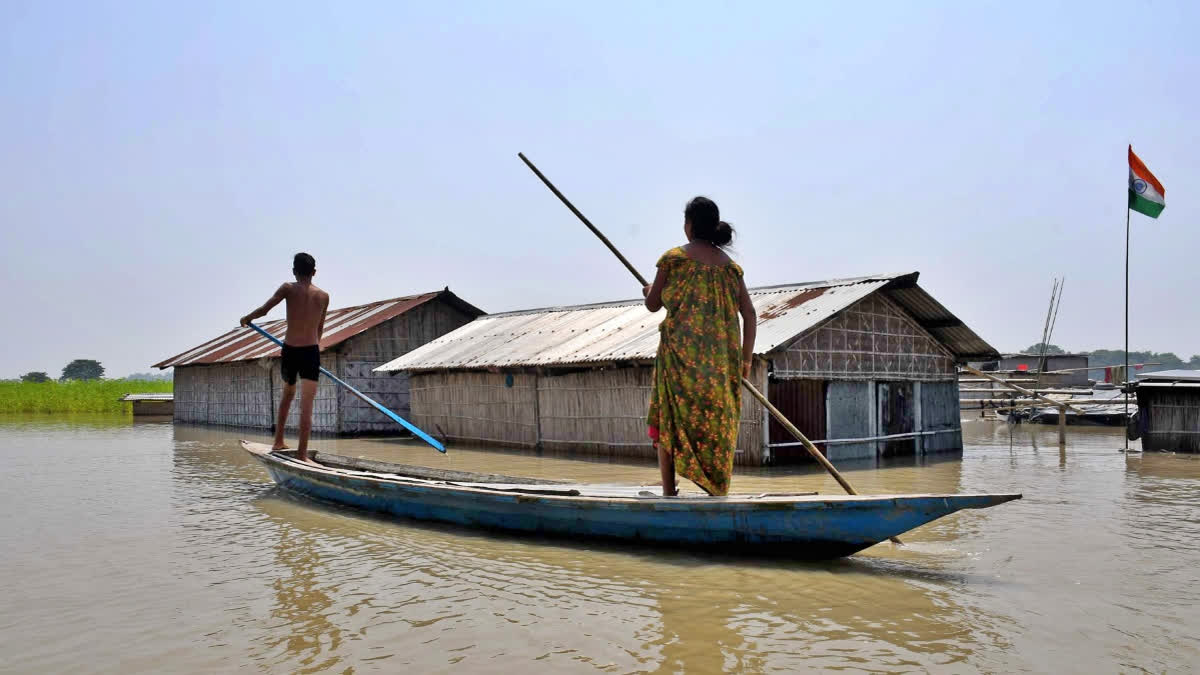New Delhi: Union Home Minister Amit Shah on Sunday said at least 50 large ponds should be created in the northeast to divert water of the Brahmaputra to help tackle floods and develop agriculture, irrigation and tourism.
Chairing a review meeting on preparedness for flood management during the monsoon, Shah also emphasised on optimum use of satellite imagery provided by the Indian Space Research Organisation (ISRO) for flood and water management. He also took stock of the preparations to deal with Glacial Lake Outburst Flood (GLOF).
Shah said efforts should be made to upgrade the forecast system of water level of rivers for better flood management. He said at least 50 large ponds should be created in the northeast so that the water of the Brahmaputra can be diverted and stored in these ponds, according to an official statement.
This will help develop agriculture, irrigation and tourism in those areas at a low cost and also help tackle floods, eventually benefiting the local economy, he added. Recurring flooding of the Brahmaputra is a major issue for Assam and the northeastern region as it claims scores of lives and inundates thousands of hectares of land every year.
Many people were killed, hundreds rendered homeless and communication lines and road networks snapped in Sikkim and Uttarakhand in the last few years following flash floods created due to the glacial lake outburst, which has become another major concern for the government during monsoon.
The home minister said the natural drainage system should be an integral part of the designs of road construction to deal with their inundation in case of floods. Shah said under the leadership of Prime Minister Narendra Modi, India's disaster management is moving forward with a 'zero casualty approach'.
He instructed the departments concerned to conduct a detailed study of the recent floods in Sikkim and Manipur and submit a report to the Union home ministry. The home minister said flood monitoring centres of the Central Water Commission (CWC) should be in accordance with the requirements and of international standards.
Shah emphasised on the need to integrate weather, rainfall and flood warning related apps developed by various departments. He also reviewed long-term measures to formulate a comprehensive and far-reaching policy to mitigate the menace of floods in the country, the statement said. During the meeting, the home minister also reviewed the action taken on the decisions made during last year's meeting.
Along with this, new technologies being adopted by all the agencies and the expansion of their network for flood management were also discussed. Shah appealed to all states and Union Territories to timely implement the advisories issued by National Disaster Management Authority (NDMA) for flood management.
He directed the India Meteorological Department (IMD) and the CWC to complete the process of recalibrating all the equipment used in flood forecast at the earliest. He also directed to ensure that floodgates of all major dams are in good condition. The home minister said the non-perennial rivers are prone to more soil erosion and siltation, resulting in floods.'
He instructed the NDMA and the Union Ministry of Environment, Forest and Climate Change to take appropriate precautionary measures to prevent incidents of forest fire. For this, the home minister stressed on the need to regularly remove dry leaves and conduct mock drills with local residents and forest personnel.
Along with this, he also asked to analyse the incidents of repeated forest fires at the same place. Shah asked the NDMA to prepare a detailed manual to deal with incidents of forest fires. He directed that the IMD's alerts regarding lightning strikes should be disseminated to the public on time through SMS, TV, FM radio and other media.
He emphasised on the need to integrate weather, rainfall and flood warning related apps developed by various departments so that their benefits could reach the targeted population. Shah directed that since the community is the first responder at the time of any disaster, there should be coordination and integration in the community awareness programmes being run by various agencies so that they can have the maximum impact.
During the meeting, IMD, CWC, NDMA and the National Disaster Response Force made detailed presentations. The departments concerned also provided information on the action taken on the home minister's instructions given during last year's review meeting. They also apprised him about the preparedness for the current monsoon season and the future action plan.
Every year, large swathes of Bihar, Assam and other eastern states are inundated due to a rise in the water level of various rivers due to monsoon rains. Uttarakhand, Himachal Pradesh, Sikkim and a few other states also encounter landslides and other rain-related issues during the monsoon. Tamil Nadu, Kerala, and Jammu and Kashmir have also witnessed flooding in recent years. Union Jal Shakti Minister CR Paatil, Minister of State for Home Nityanand Rai and top officials attended the meeting.



